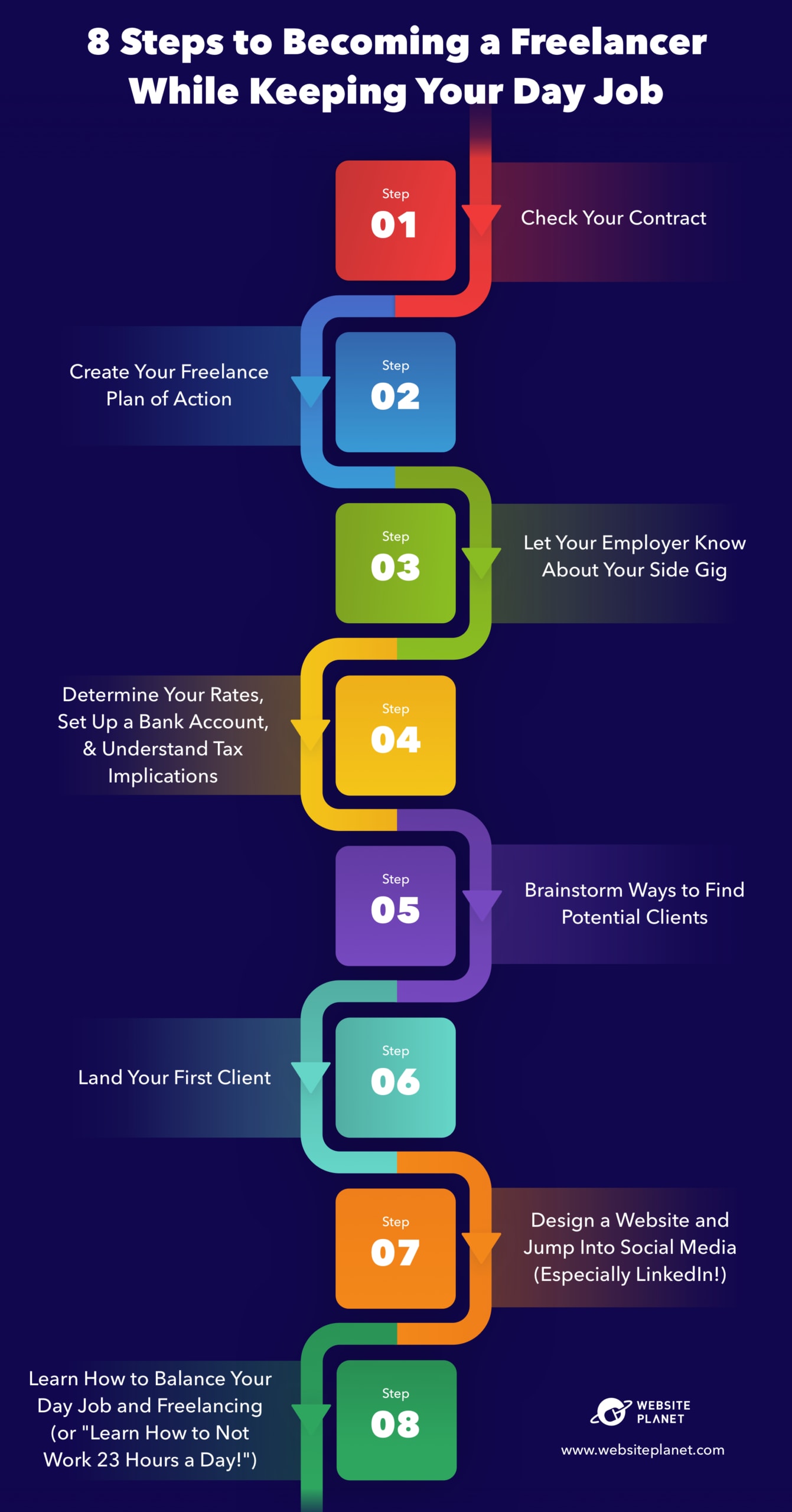1. Check Your Contract
The very first thing you need to do is make sure you are legally allowed to freelance on the side. Remember back when you got your job, you probably signed a bunch of forms? Sometimes, in the many pages of big legal words, there are clauses that prohibit you from freelancing or limit the types of clients you can work with as a freelancer. Your contract may also require you to inform your current employer of any side gigs. Note exactly who you should contact, what forms you need to fill out, and any other important information. But don’t do this right now. You need to have a plan before you dive right in. Your employer will likely have questions, and you want to have all the answers – or at least be able to intelligently speak about your new freelancing business. Next, check to see if there are any non-compete clauses that you signed when you took the job. Many apply to your next full-time job, but can also carry over to freelancing. Note any specific industries or clients that are mentioned as being off-limits. This might start to feel overwhelming, but don’t panic. In a minute, I’ll share some creative ideas to help you build a business that doesn’t violate your current terms of employment.2. Design Your Perfect Freelancing Business
Before you go any further, I want you to let go of any preconceptions you have about how your freelancing business will work. Other than the legal and tax rules, which you absolutely, positively, must follow (more on that later), there are no rules about how you should freelance. It doesn’t matter how other people run their businesses, what matters is what works for you. The beauty of freelancing is that you have the flexibility to build a business that works for your personality, strengths, weaknesses, goals, and schedule. The most successful freelancers are those who carefully craft every part of their business with each of those aspects in mind when they determine which clients they take, the type of work they do, when they work, how much they work, and how much they outsource. Freelancers who try to conform to what they think they “should” be doing often end up frustrated and not able to earn the income they want. I am the Typo Queen. I go to sleep early, but love working in the mornings. I have two teenagers and run a dog rescue on the side. I have built my freelancing business by working weekends so that I can be available in the afternoons when my kids are around. And I hire my own copy editor to catch my typos so my clients don’t fire me. Plus, I tend to look for clients that have quick turnaround times, since I know they’ll value my flexibility and availability. So carve out some quiet time, when you aren’t tired or stressed or likely to be interrupted, and create an initial business plan. Take your time and remember that nothing is set in stone. You will learn and tweak and change course many times as you go. The success of your business (and your sanity) depends on this.Create a plan that includes the following:
- Your ultimate goal. Is freelancing on the side your end goal? Or do you hope to eventually turn it into your full-time job? You can change your mind down the road, of course, but it helps to know where you are heading.
- Your timeline for going freelance full time. If you don’t dream of doing this, just skip this step. No worries. But if you do want to ultimately ditch your day job, then you really should start with a plan. Of course, this can (and will) change, but having a timeline encourages you to not procrastinate.
- What service you will provide. And no – “photographer,” “writer,” or “graphic designer” isn’t the right answer. You need to go deeper. Are you going to specialize in corporate photoshoots, writing content marketing for healthcare companies, or creating non-profit websites? Go deeper. Be specific.
- Your income goals. How much do you want to earn each month and year? Write down the bare minimum you need to earn, your realistic goal, and your stretch goal. Don’t get too hung up on these numbers, though, because you’ll have a better idea of what’s realistic once you get started.
- How many hours you will work. This will change and go up and down based on client demand. But remember that you are also going to have to devote unpaid time in getting your business up and running. But instead of thinking of it as unpaid time, reframe your thinking to focus on the fact that you are investing in yourself.
- What you will outsource. Stop looking at me funny. I know this seems crazy, but it isn’t. The easiest way to find the time is to outsource.
- When you will work. This is the most important thing (behind the legal stuff, of course) when freelancing as a side gig. More time doesn’t magically show up. And since you probably don’t have loads of free time just sitting around, it likely means you will have to give something up to make time. So if you skipped over my bullet about outsourcing, go back.
3. Ask for Permission, Not Forgiveness
Now that you’ve got a plan, it’s time to make this official. You need to tell your employer. Keeping it a secret is not a good idea. After all, you don’t want to get fired and then be scrambling to go full time as a freelancer with no notice. If you need to formally notify Human Resources, then start there. Set up a meeting, ask questions, fill out whatever forms you need to, and find out the company’s procedure. Every company is different, so get the official information and follow the process. Even if you aren’t required to fill out official forms, you still need to tell your boss. It’s both a courtesy and the right thing to do. But don’t just mention it in passing as you’re heading to lunch. Set up a formal meeting and sit down to share your plan. The biggest thing your boss cares about is that it won’t affect your work performance and you aren’t going to steal customers. Explain when you plan on doing your freelancing – on the weekends or at night. And then share the basics about where you will be getting customers, such as from a professional association you belong to. Telling your employer can also help you a lot in the long run. You are probably not the first employee to take this route. They could have some great advice. And they might even refer you to some of their colleagues at other companies looking for talent. Even better, many people who transition to full-time freelance often continue working for their past employers.
4. Get Ready to Get Paid
Nope, don’t start looking for clients just yet. First, you need to take care of your finances. Check out our Comprehensive Guide to Managing Your Finances as a Freelancer to understand all the complexities that earning a freelance income can bring.- Set up your business bank accounts. Resist the temptation to mix business and personal. Just don’t do it. It will make your life and your taxes so much easier.
- Create a tracking system for invoices, expenses, and payments. Some writers use an Excel spreadsheet. Others use Wave, which is a free tool. I have been using FreshBooks for years, and it has improved my business dramatically. You can also read my experience with AND CO here, which is another great option.
- Think about your own rates. Now we’re finally getting to the fun part…or the stressful part. It’s important to price yourself right. Too high and you won’t get work, but too low and you’re losing money. No pressure. But before you stress out too much, read our Guide to Price Your Freelance Work.
5. Create a Potential Client List
The biggest resource you have going for you are your connections. You can’t approach your current employer’s clients, but there are many ways you can leverage your experience and relationships without breaking any rules or ethics. One of the best ways is to position yourself in a niche that is related to, but not competing with, your current job. For example, let’s say you’re a copywriter for a large hotel chain. Working for other hotels is likely going to get your fired from your day job. But hotels have restaurants. And you’ve likely worked on many restaurant-related projects. So a perfect niche for would be writing for restaurants not associated with hotels. You aren’t competing, but you are using your experience.- Former co-workers at your current job who are now working at other companies
- Your past employers
- Customers you worked with at former jobs
- Customers you worked with at your current job who are now with new companies
- College colleagues
- Vendors at your current and past jobs
- Friends, family, and neighbors who work at companies in your niche
- People you have connected with on social media through networking groups
- Local community groups where your potential clients hang out
6. Land Your First Client
Yep, just dive in. Many people starting a freelance business spend months creating fancy materials and plans. But honestly, you just need the basics – and then the best thing to do is get your first gig. Why? Because your first client will almost definitely be someone who knows you and your work. And this eliminates the analysis paralysis that I see so many people get stuck at. So go back to the list you just created, and reach out to your contacts. LinkedIn or email is often a good starting point depending on your relationship. Keep your email short and sweet. Let them know that you are freelancing. Refresh their mind about your qualifications. Ask if they can refer you to the correct department at their company. And then hit send. But don’t just assume that if you don’t hear back that they don’t want to help you out. It’s more than likely that it’s buried in their inbox. Or they read it on their phone from the sidelines of the soccer game and forgot to reply when they were at work the next day. So be sure to send a polite follow-up note. One of my favorite mantras is that if you don’t follow up, you are likely leaving money on the table. Other options for your first gig include working through a platform. The How to Find a Freelance Job chapter of our Ultimate Guide to Being a Freelancer walks you through the different platforms available and how to use them. That said, freelancing platforms should only be one tool that you use to get gigs, not your only marketing method. The most successful freelancers use many different ways to get work, including agencies, platforms, and direct clients.7. Create Your Marketing Materials
That’s right, I said to land your first client before creating your marketing materials. The reason is that you can easily spend too much time getting prepared. And it’s very likely that there’s a client that you can land quickly because they already know you and your work. Once you have a paying client, take a step back and create the following marketing materials:- A website. This is super important. And can help you look more professional and even “bigger” than you are. I highly recommend creating a basic website right from the start.
- Social profiles. This chapter of our Ultimate Freelancing Guide walks you through how to write awesome profile pages. That said, platforms typically offer lower paying gigs than you can find on your own. Be sure to use freelancing platforms as one way to get work, but don’t rely on platforms for all your gigs.
- A business email. This should be separate from your personal account. Be sure to add a tagline to your signature, with a link to your website/portfolio.
- An updated LinkedIn page. Prospective clients often search for freelancers on LinkedIn. And you want to be easily found. Be sure to put in your past clients and all your niches. Think about what search words your ideal client is likely to use, and include all those in your profile.
8. Balance Your Day Job with Freelancing
Once you get one client and are successfully managing your work, consider adding another. It’s important to make sure that you are managing your responsibilities at your full-time job. Here are three tips for successfully balancing both working a full-time job and freelancing on the side:- Don’t sacrifice sleep or exercise. You can only continue to do your best work at your day job and for your new freelancing clients if you are healthy and well rested. Make sure that you continue getting enough sleep and exercise. Resist the temptation to eat a bunch of takeout food or junk because you are spending more time freelancing. By taking care of yourself, you can continue the pace over time.
- Check in regularly with your manager. Make sure that your performance does not suffer at your full-time job. If anything, make sure that you stay later and take extra projects, especially if your manager had any concerns about you freelancing on the side. And if you have started working at home or working an alternate schedule to accommodate freelancing, be sure the regularly touch base to make sure it’s working from your manager’s perspective.
- Consider outsourcing. Paying someone to perform tasks for you, like hiring an editor to proofread your written work or engaging a virtual assistant to assist with research, often results in lower costs. As previously stated, I want to emphasize once again that outsourcing household tasks not only provides additional time but also allows you to generate income by the day’s end.
Taking the First Step
Now you know how to do it. But freelancing on the side requires motivation and persistence. It may not be easy, but the benefits are usually worth it. With a full-time job you are limited in your earnings, but not so with freelancing. Plus, if you love it, you are in the perfect position to transition your freelance gigs into a full-time job. Many full-time freelancers started while they worked a full-time job. You get the chance to test out the market and determine if the freelance lifestyle matches your strengths and personality. So take the first step and give freelancing a try on the side.
Many full-time freelancers started while they worked a full-time job. You get the chance to test out the market and determine if the freelance lifestyle matches your strengths and personality. So take the first step and give freelancing a try on the side.
FAQ
Can I start a business while working full time?
Yes. Absolutely. It can be time-consuming to get started, but it is very possible to do both. Just make sure to check your work contract to see if you are under any restrictions or obligations.
Can I work full time and freelance?
While it may take some careful time management skills to balance both, many people successfully earn extra income through freelancing while holding a full-time job.
Is doing side jobs illegal?
No. However, some employers prohibit freelancing or require prior approval. Be sure to check your contract and follow any processes required by your company before accepting any side jobs.
Can government employees freelance?
It depends. Some government agencies allow freelancing while other prohibit it. The type of freelancing and your clients may also be an issue. Government employees should carefully check their contracts and talk to Human Resources before beginning any freelance gigs.
How many hours do freelancers work?
The beauty of being a freelancer is that you can set your own schedule. You can work a few hours a week or as many as you want. You just need to take the amount of client work to match the number of hours you want to work.
How much do freelancers make?
Freelance income varies greatly by type of freelancing project as well as by client. Depending on experience level, freelance writers can make less than $10 an hour to over $100 an hour.
What freelance jobs pay the best?
The general guideline is the more experience and skill a freelance job requires, the more you will earn. So virtual assistants typically earn less than computer programmers, for example.
Main Page: The Ultimate Guide to Being a Freelancer
Chapter 1: Finding a Freelance Job
Chapter 2: How to Create a Winning Freelance Profile
Chapter 3: How to Price Your Freelance Work
Chapter 4: How to Book a Freelance Job
Chapter 5: How to Discuss a Freelance Project with Your Client Before You Start
Chapter 6: How to Navigate the Freelance – Client Relationship
Chapter 7: How to Manage Your Time as a Freelancer for Maximum Productivity
Chapter 8: How to Get Paid as a Freelancer
Chapter 9: Managing Your Finances as a Freelancer – A Comprehensive Guide
Chapter 10: How to Advance Your Freelance Career
YOU ARE HERE – Chapter 11: How to Become a Freelancer & Keep Your Day Job
Feel free to share this article and/or copy this post or parts of it to your website, blog, or social networks. All we ask is that you attribute it to WebsitePlanet.com










